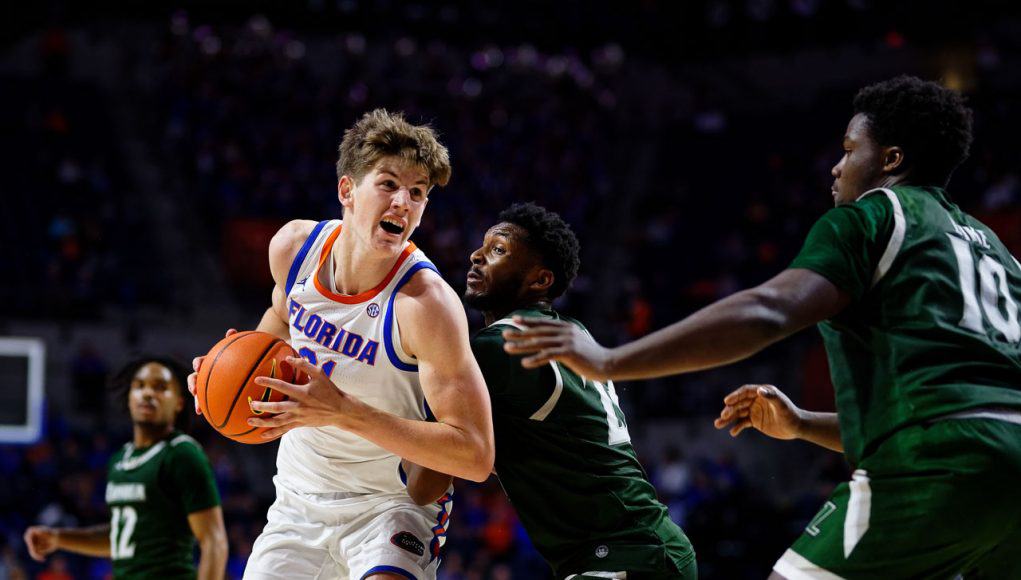When it comes to the identity of Florida Gators basketball this season, it’s all about offensive rebounding.
In a podcast interview Tyrese Samuel mentioned that when the team was working in the offseason offensive rebounding wasn’t made a focus, but when games started the mix of length, athleticism, and competitiveness among the frontcourt players resulted in an all-out assault of the offensive glass.
When Florida has won games this year it has largely been due to their work on the offensive glass. Florida had 20 offensive rebounds against Florida State, 24 offensive rebounds against Merrimack, and 21 offensive rebounds against Michigan–and the biggest play of that game was a Zyon Pullin three-pointer to send the game into overtime which came off of a, you guessed it–offensive rebound that turned into a kick out for the open look.
Currently the Gators are 6th in the country in offensive rebounding rate grabbing exactly 40% of their misses. From the opening game of the season Florida was hammering the glass and found themselves near the top of the country in the metric and they have climbed as high as 2nd. Now 14 games into the season the question has to be asked–is this sustainable?
Right now the Gators are 139th in the country in raw points per possession (not adjusted for quality of competition). It has been a challenge for them to consistently create and make good shots, and the offensive rebounding has allowed easy putback opportunities and extra possessions to account for the sub-optimal efficiency. With offensive rebounding being so valuable to this team they’ll likely need to keep it up through the SEC if they’re going to maintain this level of play, so let’s take a look to see if it’s possible.
We know that Florida is 6th in the country in offensive rebounding rate but to add context, we should look at where their opponents have ranked in defensive rebounding rate in order to see if the Gators are truly that dominant on the glass or if they were capitalizing on weak rebounding teams. Here is where all of Florida’s opponents rank in defensive rebounding rate, per KenPom:
Loyola Maryland: 190th
Virginia: 212th
Florida A&M: 304th
Florida State: 258th
Pittsburgh: 9th
Baylor: 122nd
Wake Forest: 173rd
Merrimack: 356th
Richmond: 104th
East Carolina: 283rd
Michigan: 244th
Grambling State: 322nd
Quinnipiac: 70th
Kentucky: 111th
The average ranking–197. This would suggest the Gators have, on average, played against worse defensive rebounding teams than the national average.
What’s perhaps more interesting when looking at these numbers is that there appears to be at least some correlation between the quality of the team’s defensive rebounding and Florida’s offensive rebounding against them. As we know Florida had huge offensive rebounding games against Florida State, Merrimack, and Michigan–and you can see those teams aren’t very good on the defensive glass.
On the flip side, when Florida has played good defensive rebounding teams like Pittsburgh, Richmond, and Kentucky–the Gators had offensive rebounding percentages of 18%, 34%, and 26%–below their average of 40%.
That isn’t to say that the Gators aren’t capable of offensive rebounding against good defensive rebounding teams as they did have a 39% offensive rebounding rate against Quinnipiac and 46% against Baylor.
So, the quality of competition seems to play somewhat of a role in Florida’s offensive rebounding and they have probably been aided a bit by playing a lot of poor defensive rebounding teams. Additionally, by looking at the numbers we can see a correlation between how a team defensive rebounds and how Florida could offensive rebound against them.
Let’s take a look at the defensive rebounding numbers of the SEC:
Tennessee: 71st
Auburn: 55th
Alabama: 134th
Kentucky: 111th
South Carolina: 63rd
Georgia: 216th
LSU: 266th
Mississippi State: 59th
Texas A&M: 171st
Arkansas: 121st
Ole Miss: 319th
Missouri: 314th
Vanderbilt: 33rd
The average ranking–149th.
That’s a bit of a step up from the average team the Gators played in non-conference play, but the average is brought down by a few teams that have been pitiful on the defensive glass.
It’s worth noting that I listed these teams in order of projected finish on KenPom (as of January 9th when this is being written). Will Florida be able to dominate some teams on the offensive glass? Absolutely. It looks like Georgia, LSU, Ole Miss, and Missouri could be in for some rough nights trying to keep the Gators off the glass. However, when you look at the top teams in the league–nearly all of them are sound on the defensive glass, if not very good in that area. Florida’s ability to dominate rebounding has already shown to give them a high floor–they didn’t struggle very much at all with the lesser opponents on their schedule, and a large reason why was due to the offensive rebounding. However, if the Gators are going to beat good teams, it doesn’t look like they’re going to be able to do it simply by grabbing every missed shot.
Florida next plays Ole Miss, a team that hasn’t been good when it comes to defensive rebounding. If things continue along the same track as the season has so far–Florida should grab a whole lot of offensive rebounds. After that they’ll see Arkansas and Tennessee where we can really start to see if the style of play is sustainable.


